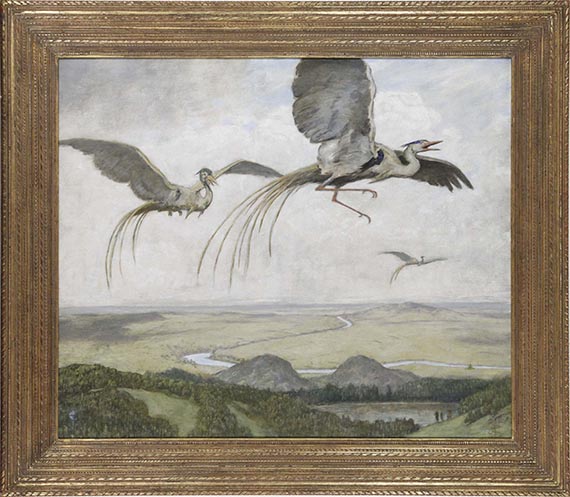309
Hans Thoma
Wundervögel, 1917.
Oil on canvas
Estimate:
€ 20,000 / $ 21,400 Sold:
€ 35,560 / $ 38,049 (incl. surcharge)
Wundervögel. 1917.
Oil on canvas.
Lower right monogrammed and dated. With written and typogr. numbers on the reverse of the stretcher. 80.5 x 95.5 cm (31.6 x 37.5 in).
PROVENANCE: Paul und Beth von Bleichert, Leipzig (presumably acquired in 1917).
Paul und Beth von Bleichert, Zürich (1920s, family-owned until 2014).
Jack Kilgore & Co. Gallery, New York.
Daxer & Marschall, Munich.
Private collection Baden-Württemberg.
LITERATURE: Cf. Henry Thode, Hans Thoma, Stuttgart/Leipzig 1909, pp. 355, 421.
Joseph August Beringer, Der Malerpoet, Munich 1917, no p., fig. plate 17.
Oil on canvas.
Lower right monogrammed and dated. With written and typogr. numbers on the reverse of the stretcher. 80.5 x 95.5 cm (31.6 x 37.5 in).
PROVENANCE: Paul und Beth von Bleichert, Leipzig (presumably acquired in 1917).
Paul und Beth von Bleichert, Zürich (1920s, family-owned until 2014).
Jack Kilgore & Co. Gallery, New York.
Daxer & Marschall, Munich.
Private collection Baden-Württemberg.
LITERATURE: Cf. Henry Thode, Hans Thoma, Stuttgart/Leipzig 1909, pp. 355, 421.
Joseph August Beringer, Der Malerpoet, Munich 1917, no p., fig. plate 17.
Hans Thoma expressed the human longing to overcome gravity in weightless flight in paintings of his so-called "miracle birds". Such a fantastic bird appeared for the first time in the painting "Paradise" from 1876 (Thode p. 89). Another painting entitled "Sehnsucht" (Thode p. 427) from 1900 shows a young man in a wide river landscape gazing at migrating birds in the sky. Particularly fascinating, however, are the paintings in which the viewer flies with the birds, as it were, far above the gentle landscape in a space permeated by unreal, bright light. In them, Thoma combines the wide-winged cranes familiar from East Asian art with the long feathers of the bird of paradise, and in some cases peacocks. He also made etchings of the motif he then used as his own bookplate, in which he particularly emphasized the ornamentality of the birds. He also seems to have attached a personal character to the bird pictures, as he dedicated such a drawing to his friend Philipp Röth for his 60th birthday and Henry Thode also owned one of the paintings. However, the miracle bird also stands for the realm of fantasy and art that does not feel bound to reality. In various flying postures, the large animals with their curved necks and feathers float above the landscape, allowing the viewer a new perspective. The dreamlike feeling of floating is of essential importance to Thoma: "In my pictures and their space, one should be able to fly" (J.A. Beringer, Vollständiges Verzeichnis der radierten Platten und ihrer Zustände, Munich 1923, p. XIV). The art historian Joseph August Beringer also pointed out that the phenomenon of flying could have exerted a particular attraction on Thoma, especially at the time when aviation technology was just beginning. The unreal feeling is palpable in so many of Thoma's paintings. Floating in space, the feeling of freedom and the longing for it were repeatedly addressed by Thoma in the form of the miracle birds. The curved lines of the animals are also reminiscent of Art Nouveau and Japanese woodcuts, which were popular at the turn of the century. [KT]
309
Hans Thoma
Wundervögel, 1917.
Oil on canvas
Estimate:
€ 20,000 / $ 21,400 Sold:
€ 35,560 / $ 38,049 (incl. surcharge)




 Lot 309
Lot 309 

